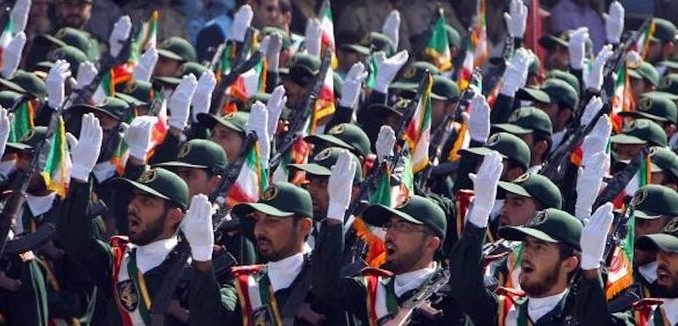One of the twelve terrorists killed in yesterday’s air strike on a Hezbollah convoy in Syria was identified by Iran as a general in the Islamic Revolutionary Guard Corps (IRGC), The Times of Israel reported today, citing a source who was quoted by Agence France-Presse.
“The Israeli strike killed six Iranian soldiers, including commanders, as well as the six members of Hezbollah. They were all in a convoy of three cars,” the source said, speaking on condition of anonymity.
Iranian general Mohammad Ali Allahdadi was among those killed in the strike, Iranian officials said.
“General Mohammad Ali Allahdadi and a number of fighters and Islamic Resistance (Hezbollah) forces were attacked by the Zionist regime’s helicopters,” said a statement on the Iranian Revolutionary Guards Corps’ (IRGC) website.
Allahdadi was reportedly in charge of supporting the Shiite militias fighting for Syrian President Bashar al-Assad. Two months ago, news reports observed that Iran was coordinating the efforts of Syria’s Shiite militias.
The Times also provided more details about the others who were killed in the strike.
The operatives killed in the strike included Abu Ali Tabatabai, who Channel 10 called the head of the group’s offensive operations; Jihad Mughniyeh, the son of Imad Mughniyeh, a senior Hezbollah commander killed in Damascus in 2008; and Mohammed Issa, responsible for the organization’s operations in Syria and Iraq.
According to Israel’s Channel 10, Tabatabai was the likely target of the strike and was responsible for planning attacks on northern Israel. Issa commanded Mughniyeh, and the two were responsible for Hezbollah’s forces on the Israeli-Syrian border. Mughniyeh was reported to have been assigned to that position in October.
Hezbollah expert Matthew Levitt of the Washington Institute for Near East Policy wrote in December that Hezbollah would be looking “to deter Israel from taking advantage of the fact that Hezbollah is enmeshed in the Syrian war.”
Iran is also supplying Hezbollah with missiles capable of threatening Israel. Michael Segall wrote on this issue last month an analysis for the Jerusalem Center for Public Affairs.
In November 2014 the Tasnim News Agency, identified with the IRGC, interviewed Nasrallah’s deputy Sheikh Naim Qassem, who acknowledged that Iran is playing a leading role in expanding Hizbullah’s missile arsenal and capability in Lebanon both in terms of quality and quantity, and that this involves training, maneuvers, and the creation of various missile units. Qassem remarked, “Israel is well aware that Hizbullah has missiles of pinpoint accuracy [a broad hint at the Fateh-110 missiles] and thanks to the Iranian materiel and aid, the next round of warfare will be very difficult for Israel.” He emphasized that: “When we are talking about the missile capability, it does not mean that only a number of Iranian missiles are delivered to the resistance [movement], but such capability includes the entire necessary items for missiles.” Qassem also referred to the missiles that Hizbullah fired during the Second Lebanon War (Fajr, Raad), which helped move the fighting into Israeli territory. He added that rockets had also played a central role in the Palestinians’ rounds of warfare with Israel in 2008 and in 2014, when rockets struck the heart of Tel Aviv and other sensitive locations in Israel.
Missiles meant for Hezbollah are first shipped to or manufactured in Syria. Hezbollah’s presence in Syria is not only in support of the Assad regime, but also a means of boosting its arsenal against Israel.
In Don’t Be Fooled. Hezbollah is Bigger and BaddAer Than Ever, which was published in the March 2014 issue of The Tower Magazine, Shai Oseran and Stéphane Cohen warned:
But while the group’s mission hasn’t changed, its strategic significance has. Because of its location on Israel’s northern border, Hezbollah terrorism has been a serious headache for the IDF since Israel withdrew from Lebanon in 2000; along with the group’s attempt to corrupt Israeli society by smuggling drugs across the border, a source of both revenue and intelligence. And its evident subordination to Tehran has meant that Iran has now established a substantial military presence in both Syria and Lebanon, combining with the Syrian army and the IRGC to create what Israeli military officials now see as a single northern front across Syria and Lebanon, rendering previous security doctrines and realities obsolete.
For all intents and purposes, Iran is now sitting on Israel’s northern border, making the Iranian nuclear threat a lot more immediate for Israeli decision-makers. If military grade missiles, rockets and unmanned aircraft systems are making their way into Hezbollah’s hands, it is not difficult to imagine tactical nukes and dirty bombs aimed directly at Israel’s northern civilian population.
But even without nuclear weapons, Hezbollah may have already strengthened to the point that it is the most difficult enemy facing Israel today. And this should be of concern not only to Israel, but to anyone interested in a stable Middle East. Not to mention any Western world leader concerned with protecting their own people from the long arm of this global terrorist menace. that has in the last two years, attacked or attempted to bomb, India, Bulgaria, Georgia, Cyprus, Syria, and even, Washington D.C.
[Photo: Andrew Prophet / Flickr ]




